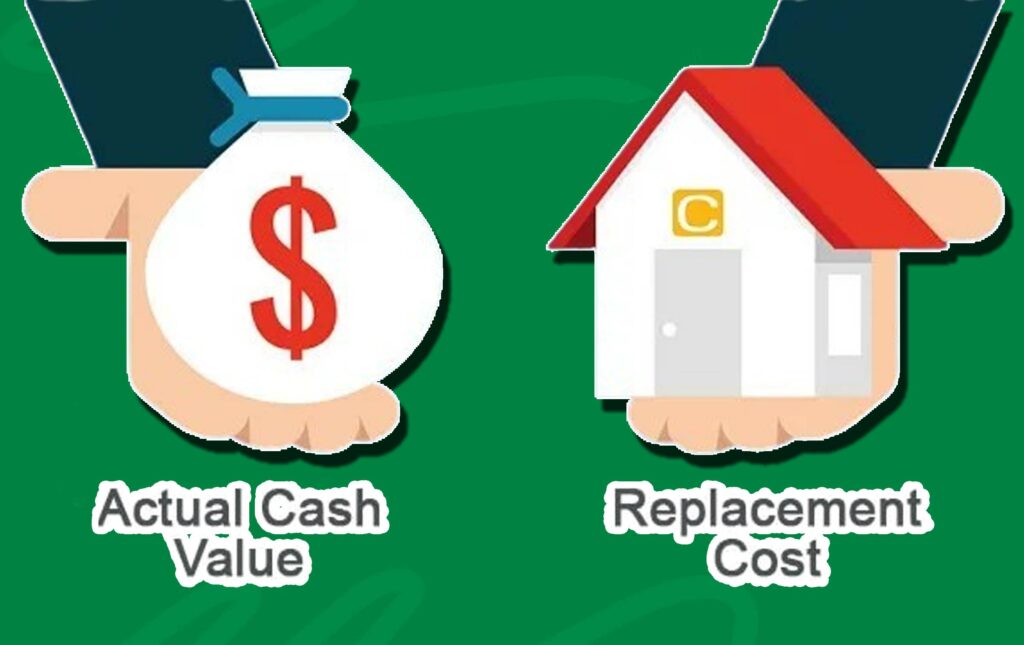In the world of property insurance, it is important to understand the differences and nuances between actual cash value and replacement cost to make informed decisions about claims and coverage. This brings us to the question: actual cash value vs. replacement cost. Most of the time, people wonder which is better.

Although both terms are associated with how insurance quotes value lost or damaged properties, they have distinctive approaches. In this article, we will explore Actual Cash Value vs. Replacement Cost.
What is Actual Cash Value?
Actual cash value, also known as ACV, is a mechanism typically used by insurance providers to find out the value of a property during a loss. Furthermore, it checks for the property’s depreciation, which shows the decrease in the value.
However, this may be due to factors such as aging, obsolescence, or general wear and tear. The actual cash value is typically determined by subtracting depreciation from the property’s replacement cost.
How Does It Work?
To calculate actual cash value, the insurance company or insurance provider will begin with the replacement cost of the property. This is the amount required to replace the lost or damaged item with a new one or something similar.
Thus, depreciation is removed or subtracted from the replacement cost. For instance, if a refrigerator 10 years old has a replacement cost of $1,000 and is damaged, the depreciation is evaluated at 50%. Therefore, the ACV will be $500.
Pros and Cons
Meanwhile, here are the benefits and drawbacks of actual cash value:
Pros:
- Cost efficiency.
- Transparency.
- Lower premiums
- Encourages maintenance.
- Also, straightforward calculation.
- Cost efficiency.
- Fixed payments.
- Affordability.
- Also, mitigates overpayment.
Drawbacks/Cons:
- Underinsurance risk.
- Wear and tear impact.
- Lower payouts.
- Older items or properties receive less coverage.
- Subjective depreciation rates.
- Financial strain.
- Potential gaps.
- Complicated depreciation determination.
What is Replacement Cost?
Replacement cost is an insurance valuation system where the insurance provider compensates the policyholder for the replacement of lost or damaged property with a new or similar kind, without depreciation accounting.
In other words, depreciation is not considered. This method makes sure that the insured can replace their property with a new one no matter the condition or age of the original one.
How Does It Work?
Under a policy that has replacement cost, when a covered item or property is lost or damaged, the insurance provider will offer payment that is equal to the required cost to buy a new one or something similar.
For example, if a 10-year-old television that cost $800 originally now costs $1,200 to change currently, the insurance company will cover the full amount ($1,200) for replacement. Moreover, depreciation is not taken into account; therefore, the insured can get a new one without worrying about financial losses.
Pros and Cons
Meanwhile, here are the benefits and drawbacks of replacement cost:
Pros
- No depreciation deduction.
- Full replacement coverage.
- Modern upgrades.
- Peace of mind.
- Also, increase coverage.
- Correct reimbursement.
- Easy to budget for.
- Excellent for high-value items or properties.
Drawbacks/Cons
- Possible overpayment.
- Higher premiums.
- Potential disputes or disagreements between the insurance company and the insured.
- High risk for insurance providers.
- Complicated claims process.
- Requires periodical policy reviews.
- Not suitable for everyone.
- Inflation impact.
Actual Cash Value vs. Replacement Cost
In this section, we will be discovering the differences between actual cash value and replacement cost. You also get to learn which aspect they work better in, and with this, you will have no issue making the right decision. Now, let’s get into it:
| Aspect | Actual Cash Value | Replacement Cost |
| Payout Amount | Usually lower | Usually higher |
| Modern Upgrades | Not covered | Covered |
| Valuation System | Subtracts or removes depreciation from replacement cost | Full replacement cost without considering depreciation value |
| Coverage for Older Items | Reduced | Full value coverage |
| Depreciation Impact | Yes | No |
| Calculation Complexity | Simpler | More complicated |
| Premium Amount | Lower | Higher |
| Who Is It Best For? | Best for budget-conscious individuals | Best for those who need total replacement |
| Financial Impact | Out-of-pocket expenses | Out-of-pocket expenses are not necessary |
| Claim Payment | Based on the value of depreciation | Based on the current market value |
Actual Cash Value vs. Replacement Cost: Which is Better?
Choosing between actual cash value and replacement cost depends on the circumstances and preferences of the individual. Generally, actual cash value (ACV) is better for individuals looking to reduce insurance premium costs and who have no problem covering expenses out of their pockets. This makes actual cash value more affordable, but full coverage is not attained.
On the other hand, considering replacement cost is suitable for people who are looking for comprehensive coverage without any impact from depreciation. Therefore, a complete replacement for the damaged or lost item is attained.
Moreover, it is best for high-value or newer items where the payout can be reduced by depreciation. However, keep in mind that replacement costs can lead to higher premiums, not making it suitable for everyone. In the long run, the choice between actual cash value and replacement costs should meet your preferences, property value, and financial situation.



